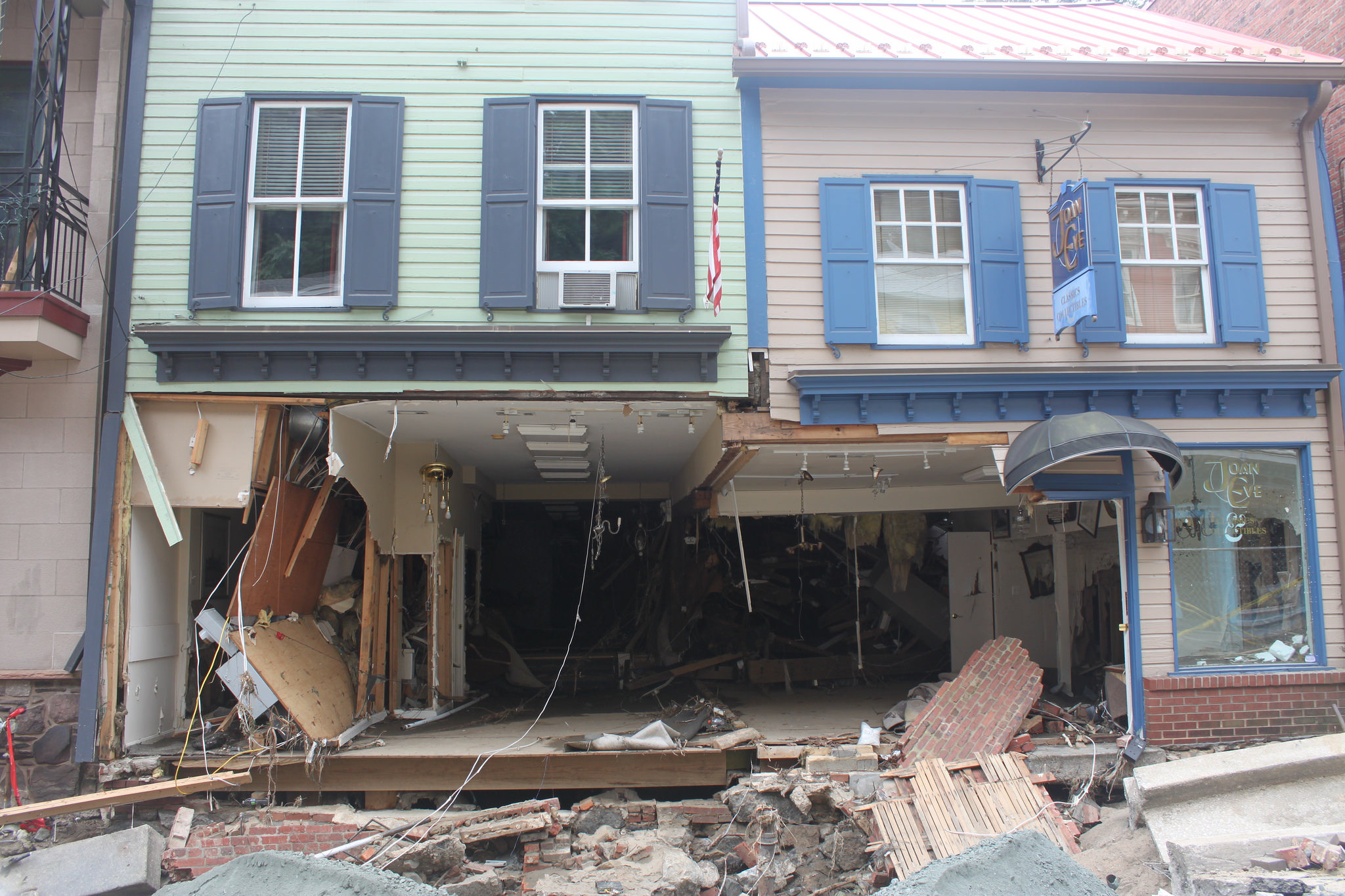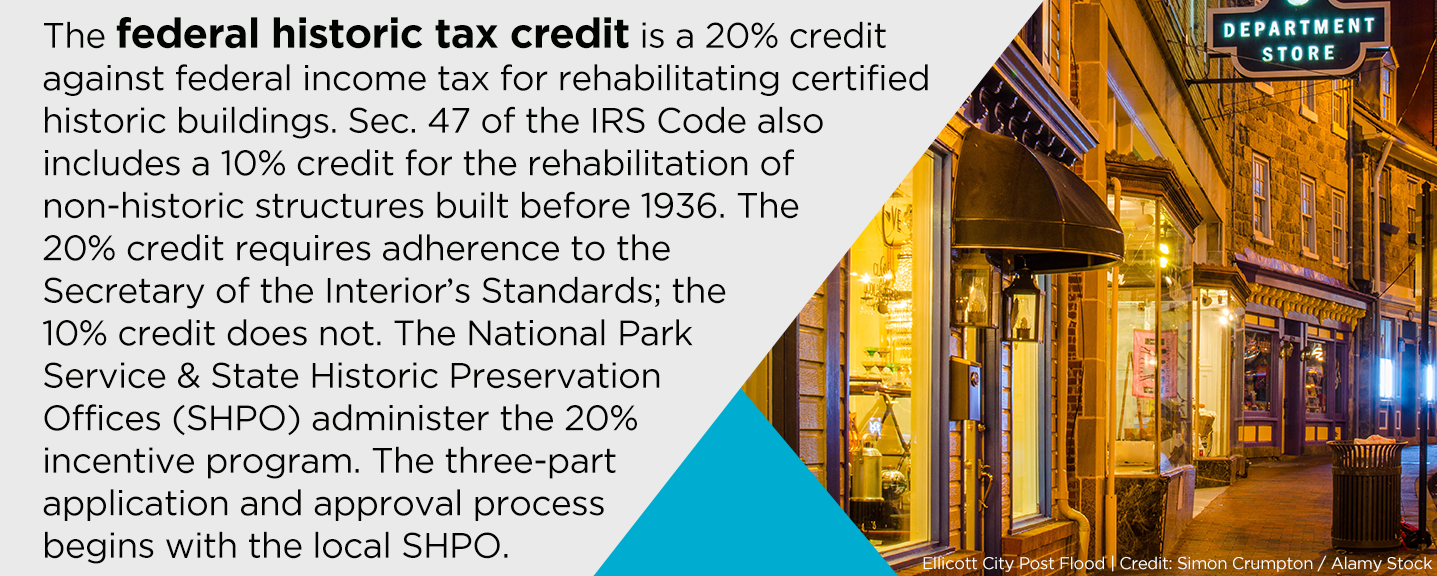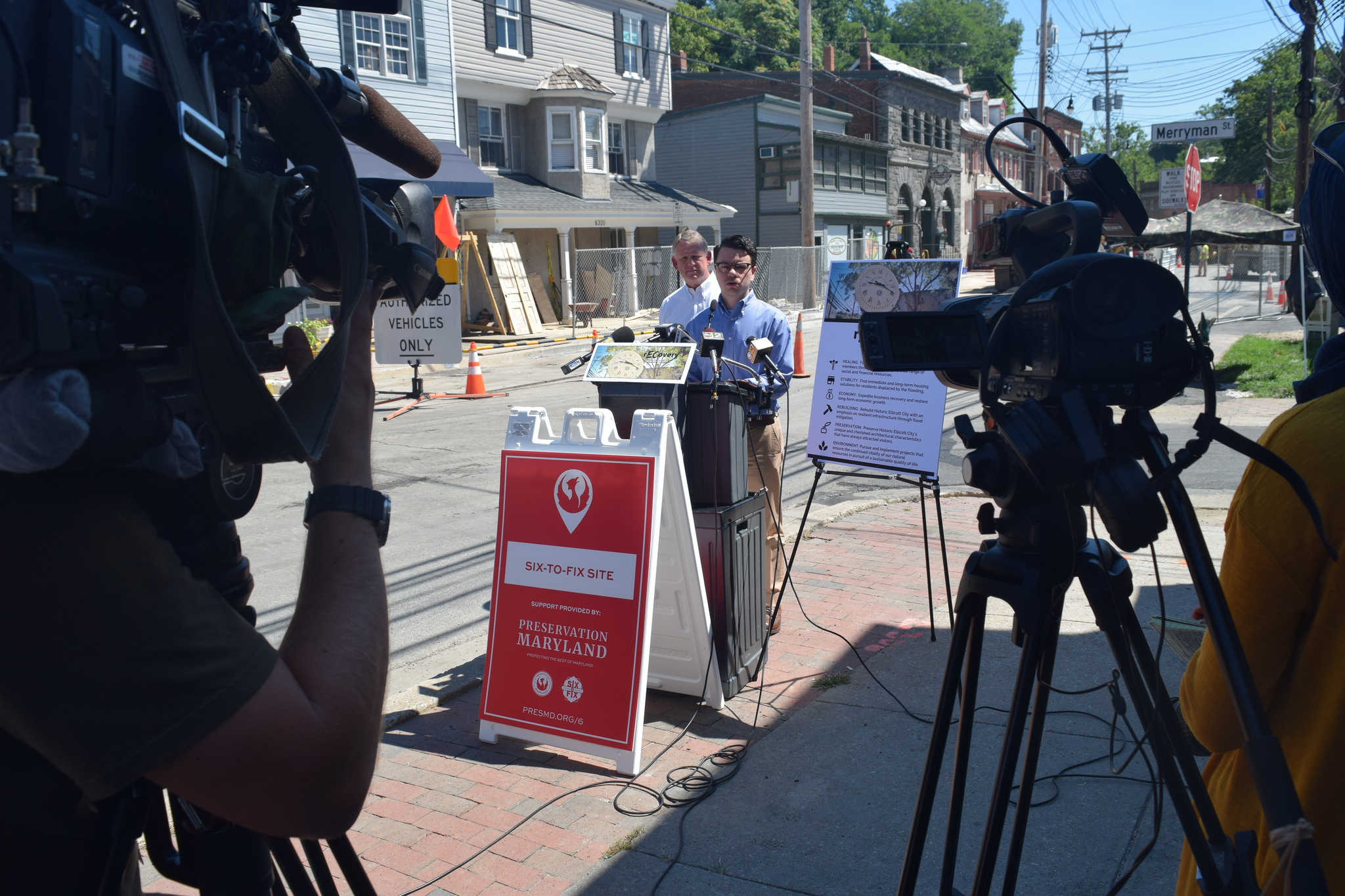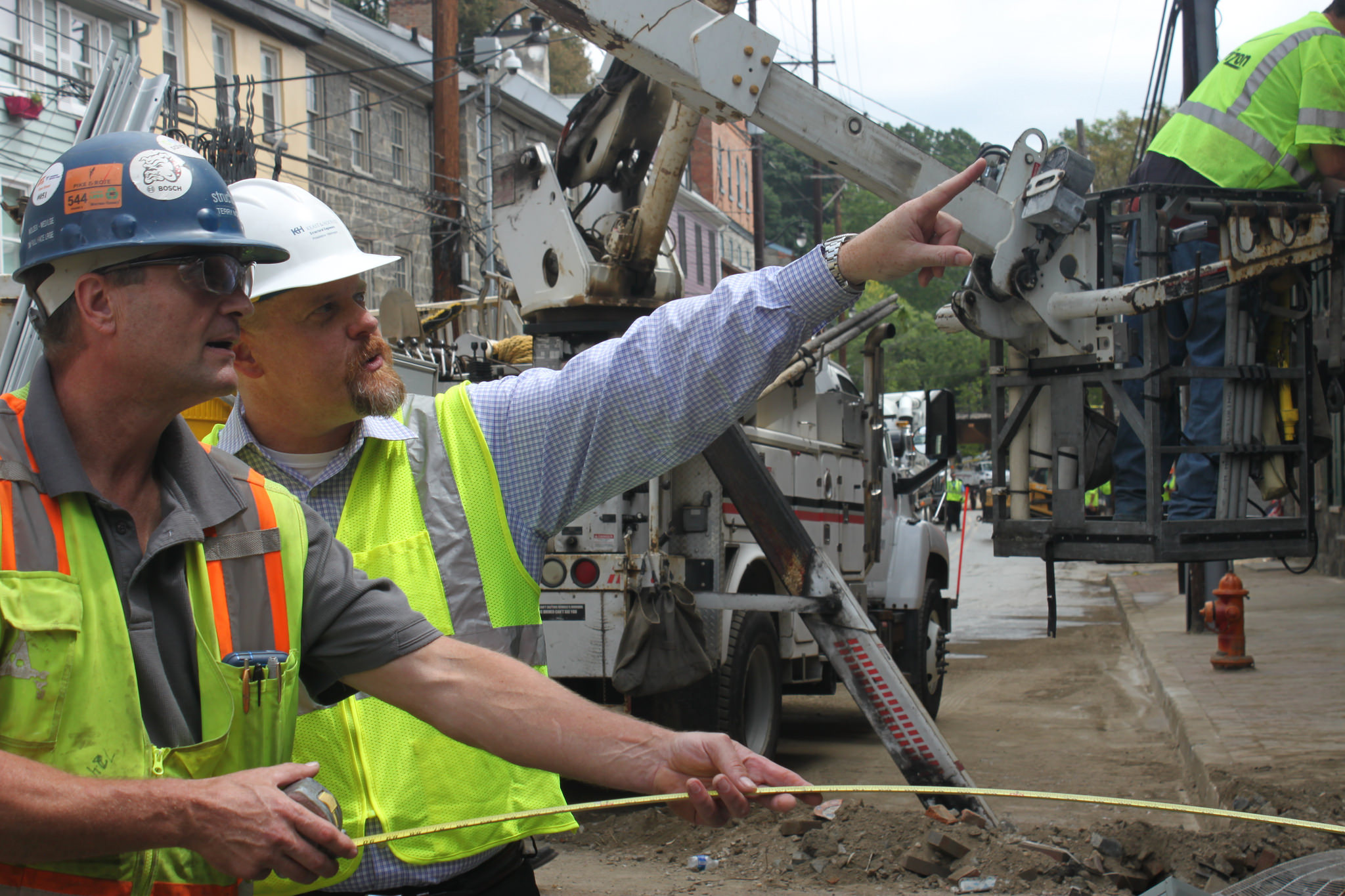Announcing the Science Discovery on Main Street Grant Recipients
Main Street America is thrilled to announce the 12 Science Discovery on Main Street grant program recipients.

Ellicott City Flood Recovery | The historic structures requiring stabilization -- they are missing the supporting wall and load bearing columns.
Credit: Preservation Maryland / Flickr CC BY-NC-SA 2.0
Both Houses of Congress have promised to produce draft legislation to overhaul the federal tax code in September 2017. On the table for possible elimination is the federal historic tax credit (HTC). As one strategy to meet this threat, legislators in both houses have introduced legislation, the Historic Tax Credit Improvement Act (HTCIA), which would modernize the HTC in the context of a reformed tax code. As described in the following article, the HTCIA would address many of the barriers to the use of the HTC for small Main Street transactions. Main Street organizations are urged to contact their Congressional delegations to co-sponsor this bill and protect the HTC from elimination under tax reform. Consider signing the National Trust’s advocacy letter and hosting a site visit for your Members of Congress during the August recess. For help, contact Shaw Sprague at ssprague@savingplaces.org
On July 30, 2016, after six inches of torrential rain, a flash flood roared down Main Street in Ellicott City, Maryland, a vibrant 18th century commercial district. Located at the confluence of Tiber Creek and the Patapsco River, this popular destination for Baltimore and Washington residents has been plagued many times over the years with damaging floods. This time, tragically, two people died, hundreds of cars were damaged or destroyed and scores of businesses were shuttered. Just under one year later, in a remarkable turnaround, 90 percent of the commercial properties are now back in service. Ellicott City is a certified Main Street Maryland community.
In the midst of this human and cultural disaster, the Main Street program, managed by the Ellicott City Partnership, collaborated with Preservation Maryland to provide a variety of disaster relief financing that helped expedite the recovery. Preservation Maryland set up a field office to provide technical assistance to property owners who qualified for the federal and state historic tax credits (HTC). The Main Street program focused on short-term emergency grants to defray the costs of immediate health, transportation and safety concerns. Main Street’s programs, described in more detail below, were a hit. But in the end, only a few buildings utilized the federal credits to help finance damage repair. (See below for a refresher on 20 percent and 10 percent HTC basics.)

What went wrong? And what does it tell us about the federal HTC and its accessibility to Main Street property owners and merchants? What improvements to this nearly 40-year-old tax incentive would increase its usage on Main Street? This article attempts to answer these questions through an analysis of what financing options were pursued by Ellicott City Main Street property owners and why.
For this article, several role players in this disaster and recovery story were interviewed including the Maryland Historical Trust (SHPO), Preservation Maryland’s field office manager, the Howard County Department of Planning and Zoning, the Main Street program and several property owners.
Disaster Relief Options Available to Property Owners
Renee Novak, an architectural historian, was selected by Preservation Maryland to manage its disaster assistance field office. She conducted workshops, offered individual consultations and filled out HTC applications. She described “layers” of other financing options through Main Street, and county, state and federal government programs. Renee said that while these various sources of relief were utilized, many property owners complained of “application fatigue.”
The State Historic Preservation Office (SHPO) reported that among scores of property owners, only four applied for federal tax credit support only. Significantly, three of those applications were for certification of non-contributing building status, an indication that the owners hoped to utilize the federal 10 percent non-historic building credit. This credit does not require SHPO and NPS design review and has no application and approval process. Owners often utilize the 10 percent credit to avoid the design requirements and added costs of complying with the Secretary’s Standards. Of the two applications for combined federal and state HTCs, one building has received Part 3 certification and another is at the Part 2 stage. Doug Harbit, Development Director at Preservation Maryland, said his organization was “astonished” at how few owners applied. The state’s low-interest loans were much more popular. Twenty-two owners received state loans and twelve closed on SBA loans.

Ellicott City Recovery Press Conference, Nick Redding | Preservation Maryland Executive Director Nick Redding speaking at a press conference on the restoration and rehabilitation of Old Ellicott City. Howard County Executive Allan H. Kittleman stands behind him.
Credit: Preservation Maryland / Flickr CC BY-NC-SA 2.0
The Main Street program, in partnership with United Way, raised over $1.8 million in donations, and operated five separate relief programs that helped 190 residents, 90 businesses and 81 property owners. In the immediate aftermath of the flood, $95,000 was distributed to upper floor residents and business and property owners in the form of $500 Ellicott City Strong mini-grants and gift cards. Another $80,000 was provided through a Safe Cleanup grant program to hire professionals to clean up properties deemed an immediate health hazard. In collaboration with Heritage Automotive, $50,000 in matching automotive grants were provided to residents, businesses and properties owners whose cars were destroyed to help them buy new cars. Preservation Maryland is also in the process of awarding grants from a $50,000 disaster fund. Owners report that they could not purchase flood insurance because their businesses were located in a flood plain. Nor were FEMA grants available since commercial businesses are not eligible.
Howard County offers a property tax credit for up to 25 percent of eligible rehabilitation expenses. It also set up a special façade improvement grant program. To cut red tape for the grants and credits, the county required that its Historic Preservation Commission meet bi-weekly instead of monthly. They also coordinated inspections and permitting from the other county departments including health and building codes.
Through many workshops and technical services, Ellicott City property owners were well-informed of their disaster relief options. With so many applications to fill out, owners clearly preferred some programs over others. The stats indicate that the county’s offerings, Main Street grants and state low interest loans were much more popular that the federal and state HTCs; this despite the fact that Preservation Maryland’s field office literally drafted tax credit applications ready for signature. Most were never sent in.

Ellicott City Flood Recovery | Mat Daw of Keast & Hood Structural Engineers meets with representatives of the Structural Group to plan the stabilization of these structures.
Credit: Preservation Maryland / Flickr CC BY-NC-SA 2.0
Case Study
Michel and Angie Tersiguel of Tersiguel’s French Country Restaurant, provided an interesting case study of how they financed approximately $250,000 in repairs. Damage was greatest in the basement and first floor of their 19th century building including the loss of two walk in freezers and the entire wine collection. As flood waters reached the first floor, staff had to relocate diners to the second floor for safety.
Taking advantage of help from Preservation Maryland, Michel and Angie applied for and received state and federal credits with a combined value of approximately $75,000. They also received a $50,000 low-interest loan from the state and $40,000 from a crowd sourcing campaign set up by friends. The balance of the costs were funded out of pocket. The Tersiguels could not obtain flood insurance and receive nothing from their property insurer.
Michel and Angie were generally grateful for the federal and state HTC assistance. However, Michel did say the programs required a high learning curve and could not provide the kind of immediate funding he needed to reopen in October of 2016. Because he and his wife could not access outside investors to provide immediate cash for the relatively small amount of credits they earned, Michel and Angie will keep the credits for their own use. But their limited annual federal tax liability will require that they carry the credits forward many years to eventually reimburse themselves for some of their repair costs. This forced the couple to “bridge” the receipt of the tax credits by putting money out of pocket to pay contractors to complete the work.
What Factors Influenced Property Owners Decision on Whether to Use the HTCs?
Preservation Maryland’s experience marketing the federal and state HTCs and feedback from owners have revealed an interesting mix of factors that ultimately led to a low utilization of federal and state HTCs compared to other disaster repair financing options.
Timeliness – As indicated by the experience of the Michel and Angie Tursiguel, the ability to turn credits into cash in time to pay the contractors is very difficult on small transactions for which there is no investor market. Owners who do not have the liquidity, cannot afford to wait many years to recoup the value of the credits. Timeliness of the application process was also a factor. At a point when owners were desperate to put their buildings back in service as soon as possible, the two-step state and federal HTC process proved too long to help with the immediate crisis despite efforts by the SHPO and National Park Service to be responsive to the crisis.
Lack of Owner Access to Investor Capital – This age-old issue for the tax credit industry put HTC usage at a disadvantage to various public and private grant funding and property tax credits. According to Renee Novak, owners were primarily interested in cash “now”, not later. The earliest tax credit proceeds to an owner who uses the credits to defray his/her own federal tax liability is not until tax returns are received the year after the building is placed back in service. Outside investors generally contribute most of their tax credit equity to the partnership before construction completion.
The Secretary’s Standards – It was revealing that three of the four federal applications reported by the state were to obtain non-conforming building status so that the owners could use the 10 percent credit which avoids the need to meet the Secretary’s Standards. Some owners noted that the Standards substantially increased the cost of repairs.
The Substantial Rehab Test - Under current HTC law, an owner must spend at least his/her “adjusted property basis” or $5,000 whichever is greater to qualify for the federal HTC. Adjusted basis is what you paid for the property, plus the cost of any prior improvements, less the value of the land and any depreciation already taken by the owner. Some potential applicants noted that the substantial rehab test would force them to spend more than they needed to place their buildings back in service.
Preference for Dealing with Local County Officials and Programs – Renee Novak reported that owners preferred dealing with nearby county officials and review boards. With limited travel schedules, SHPOs and National Park Service reviewers do fewer site visits than they would like. Howard County officials were minutes away and, as noted earlier, expedited their services to meet the needs of the property owners.
How could the Historic Tax Credit Improvement Act Help Main Street Access the HTC?
The Ellicott City story provides insight into what changes to the federal HTC might have helped a greater number of property owners. Current legislation with broad Senate and House support, the Historic Tax Credit Improvement Act or HTCIA (HR 1158 and S 425), would make several overdue changes to the federal HTC that would address many of the barriers Main Street property owners like those in Ellicott City face when considering the use of the federal HTC. Achieving a better balance between urban and small town locations and large and small transactions are the heart of the HTCIA legislation. Key provisions include:
While the 30 percent credit gets a lot of attention, the ability to sell a tax certificate instead of forming a complicated partnership with an outside investor would address the lack of investor interest in small deals. Bill sponsors believe that a new market of small deal investors, typically individuals, would likely develop for the federal HTC similar to what we have seen in 19 states that allow state HTC transfer via tax certificate.
The third provision addresses the perverse incentive under current law to spend more money on improvements than the building needs. SHPOs have reported that in rural towns, appraisals typically do not support this level of spending. Most states have already departed from federal law by lowering their minimum rehabilitation requirements to amounts such as $50,000.
The current interest in federal tax reform is the worst threat the HTC has faced since the code was last reformed in 1986. It is also the best opportunity the preservation community has had to make long overdue changes that would make the federal credit more accessible to Main Street.
Here’s How You Can Help
Sign your organization onto national letter.
Request a meeting with your members of Congress during August recess.
Send your members of Congress a request to co-sponsor the Historic Tax Credit Improvement Act
ABOUT THE AUTHOR:
John Leith-Tetrault supports the National Trust Community Investment Corporation (NTCIC) public policy efforts by engaging in high-level policy discussions with federal lawmakers and executive branch officials on a number of important issues, including comprehensive tax reform, historic tax credit (HTC) eligibility for the Community Reinvestment Act (CRA), legislation to modernize the HTC, IRS tax treatment of HTC transactions and improvements to the National Park Service’s administration of the HTC program. John chairs the Historic Tax Credit Coalition (HTCC) which has led the effort to retain the HTC in a reformed tax code. The HTCC also worked closely with the IRS to develop Revenue Procedure 2014-12 that governs how HTC transactions are structured to comply with the Historic Board Walk Hall appeals court decision. John has a Masters Degree in Urban Planning from George Washington University and a BA in History from Georgetown University. He brings over 40 years of real estate, community development, banking and tax credit experience to NTCIC. In addition to his 15 years as the founding President of NTCIC, John’s experience includes employment in various community development financing capacities with the following organizations: Neighborhood Housing Services, NeighborWorks USA, Enterprise Community Partners, Bank of America and the National Trust for Historic Preservation.